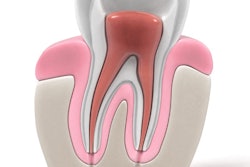
Ready to take your practice to the next level? Sonia Leziy, DDS, spoke at the California Dental Association's CDA Presents 2017 meeting in San Francisco about the most important innovations in recent years to her periodontal and prosthodontic group practice.
She covered topics that included treatment planning in implant dentistry and the use of digital technology in her practice.
"Look at the fundamentals of a treatment plan before you treat," Dr. Leziy told DrBicuspid.com. "Even in academics today, there's very little emphasis on treatment planning."
Dr. Leziy is a periodontist who practices with the Imperio Group in North Vancouver, British Columbia, and a clinical associate professor at the University of British Columbia in Vancouver.
Have a plan
Having a treatment plan is key to providing patients with good care and making fewer mistakes, Dr. Leziy explained.
"We're sometimes far too eager to just jump in and do some treatment," she said during her presentation.
Much of her treatment planning is influenced by innovations, she noted. Certain technologies allow her to preview treatment options, and she'd like to be as predictable as possible in her treatment.
"When I look at implants, I look at various risk factors to try to help me prepare for the complexity of the treatment and to communicate better," she said.
Dr. Leziy's process of aesthetic risk analysis involves the following factors:
- Assessing the risk of achieving an unaesthetic result in given clinical conditions
- Communication between clinicians and technicians
- Communication about risk factors to the patient and avoiding misunderstandings about unmet expectations
- Avoid and minimizing complications
Her aesthetic risk-factor analysis involves assessing the degree to which a patient has a low, medium, or high risk related to the following factors and others:
“We're sometimes far too eager to just jump in and do some treatment.”
- Medical status
- Smoking
- Aesthetic expectations
- Lip line
- Gingival biotype
- Shape of tooth/crown
- Infection at treatment site
- Bone level of adjacent teeth
- Adjacent restoration status
- Soft tissue anatomy
- Site bone anatomy
This process can help to set realistic expectations, Dr. Leziy said. She presented some cases that emphasized the importance of learning from failure. In one case, she had failed to initially look at the patient's whole mouth.
"I was just acting like a prescription periodontist," she said, whereas having the patient undergo some orthodontic work before receiving an implant would have been helpful.
Dr. Leziy also emphasized the importance of communicating well with colleagues from whom patients are also receiving dental care.
Immediate results
Dr. Leziy loves performing immediate implant placements when possible, which can reduce costs. However, certain patients are better candidates than others, she noted.
"It's best when they have lots of gum, nice square teeth, and lots of buccal bone," she said.
Dr. Leziy recommended considering whether a patient is low- or high-risk for immediate implantation by evaluating the following factors and potentially delaying placement if the patient is high-risk.
| Diagnostic considerations for implant placement timing | ||
| Diagnostic considerations | Best case scenario for low risk | Worst case scenario for high risk |
| Tooth position | Coronal or excess | Ideal or apical |
| Degree of scallop | Low | High |
| Biotype | Thick | Thin |
| Tooth shape | Square | Triangular |
| Sagittal root position | Engages facial plate (class I) | Engages buccal & palatal (class IV) |
| Lip line & dynamics | Low & limited range | High lip line & dynamics |
| Patient expectations | Low or realistic | High or unrealistic |
Some factors should contraindicate immediate placement, such as sagittal root position that engages buccal and palatal (class IV), one factor with which she agrees with the literature, she noted.
"Sometimes I think we have to challenge the literature," Dr. Leziy said. "I don't want to give the body time to think about shrinking. I think I have a better outcome when I do immediate implants."
Today, she is putting in smaller implants than she used to and going back to using more cow-bone products.
How you flow
Another important factor in Dr. Leziy's work is embracing digital workflows, which she says can improve efficiency and accuracy in going from planning to surgery to restoration and also allow for better communication among clinicians, technicians, and patients.
"One tool I cannot work without today is an optical scanner," she said.
Practitioners are fighting to have access to them in her office, she noted. She also likes to use digital smile design and have technicians in her office print her surgical guides.
Embracing digital technology is also important if you want to sell your practice, Dr. Leziy said.
For implants, she likes to use scanning for diagnosis and treatment planning. Nevertheless, there are some drawbacks, such as a big learning curve, incompatibilities between some systems, and varying levels of support from companies. Still, she sees this technology as the future.
"I have learned to work with my technicians in a new way," Dr. Leziy said. "I feel that the dental laboratory of the future is one that offers us services."



















